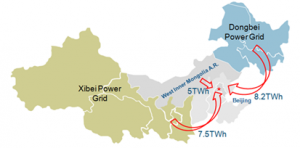China’s 13FYP increases targets for renewables while trying to address current problems of overcapacity in the power sector.

Article sources with kind recommendations of the Sino-German Energy Partnership of GIZ on behalf of the Federal Ministry for Economic Affairs and Energy (BMWi).
The Chinese government has a variety of plans that include targets for the energy sector. The most important ones for that matter are the Strategic Energy Action Plan (SEAP), the National 13th FYP and the Energy 13th FYP, the two latter valid for the years 2016-2020. During the negotiations behind those plans it became clear that the Energy 13th FYP got stricter in terms of renewable energy expansion. Table 1 depicts the clean energy targets (renewables plus nuclear) of China for 2020 according to different planning regimes.

Table 1: Chinese clean energy installation targets for 2020 (source: Energy Brainpool)
Targets for fluctuating renewables, wind and solar have been raised and 2015 levels indicate a high chance of those goals being likely to be fulfilled. The extension of hydro power has been capped by 10 GW, while the expansion target of hydro has almost been reached last year.
In addition, the share of coal in the primary energy consumption is to drop from current levels of 64 percent to 58 percent according to the Energy 13th FYP, while the share of non-fossil fuel in primary energy consumption shall be higher than 15 percent. Currently that share stands at 12 percent (roughly the same level as Germany).
Furthermore the Energy 13th FYP addresses two points that have been troubling the Chinese energy sector and policymakers alike. The Chinese power sector faces severe overcapacities. Existing capacities are seeing their lowest utilization hours since almost 40 years and many coal-fired power plants are still being built. Many of those projects were approved during the peak of the economic boom and can be seen as inertia capacities. The Energy 13th FYP thus announces a two-year “freeze period” for the approval of any new coal-fired power plants.
Also the curtailment of renewable energy has been an issue, where in 2015, 15 percent of China’s wind energy has been wasted. As long as transmission bottlenecks are not solved, the capacity targets for wind and solar are no automatism to replace coal-fired generation. Solutions that focus on reducing curtailment rather than further capacity additions might therefore be employed in the coming 5 years.



